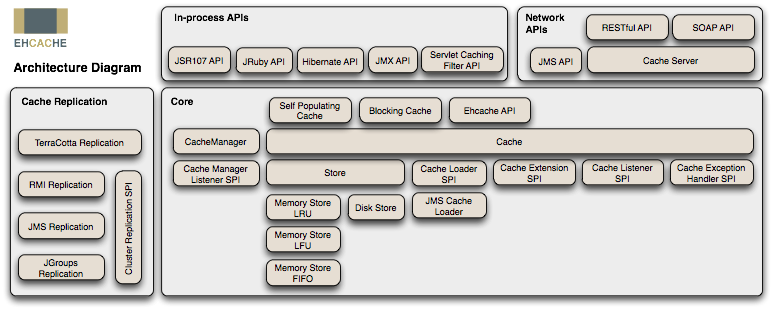1. 该说的话
每个人都应当学会独立地去思考、去寻找答案,而不是一味地伸手向他人索取所谓的标准答案。 首先,别成为“拿来主义”者,其次远离"拿来主义"的人。
2. ehcache
2.1 主要特性
- 快速,简单.
- 多种缓存策略
- 缓存数据有两级:内存和磁盘,因此无需担心容量问题
- 缓存数据会在虚拟机重启的过程中写入磁盘
- 可以通过RMI、可插入API等方式进行分布式缓存
- 具有缓存和缓存管理器的侦听接口
- 支持多缓存管理器实例,以及一个实例的多个缓存区域
- 提供Hibernate的缓存实现
2.2 和redis相比
- ehcache直接在jvm虚拟机中缓存,速度快,效率高;但是缓存共享麻烦,集群分布式应用不方便。
- redis是通过socket访问到缓存服务,java 框架项目案例:www.1b23.com 。效率比ecache低,比数据库要快很多.
2.3 在应用程序中的位置

3. spring boot 整合
1.搭建spring boot 项目
2. pom.xml文件中添加依赖
<dependency>
<groupId>org.springframework.boot</groupId>
<artifactId>spring-boot-starter-cache</artifactId>
</dependency>
<dependency>
<groupId>net.sf.ehcache</groupId>
<artifactId>ehcache</artifactId>
</dependency>
- 添加ehcache.xml配置文件
<ehcache xmlns:xsi="http://www.w3.org/2001/XMLSchema-instance" xsi:noNamespaceSchemaLocation="../config/ehcache.xsd">
<!--
磁盘存储:将缓存中暂时不使用的对象,转移到硬盘,类似于Windows系统的虚拟内存
path:指定在硬盘上存储对象的路径 java 框架项目案例:www.1b23.com
path可以配置的目录有:
user.home(用户的家目录)
user.dir(用户当前的工作目录)
java.io.tmpdir(默认的临时目录)
ehcache.disk.store.dir(ehcache的配置目录)
绝对路径(如:d:\\ehcache)
查看路径方法:String tmpDir = System.getProperty("java.io.tmpdir");
-->
<diskStore path="java.io.tmpdir" />
<!--
defaultCache:默认的缓存配置信息,如果不加特殊说明,则所有对象按照此配置项处理
maxElementsInMemory:设置了缓存的上限,最多存储多少个记录对象
eternal:代表对象是否永不过期 (指定true则下面两项配置需为0无限期)
timeToIdleSeconds:最大的发呆时间 /秒
timeToLiveSeconds:最大的存活时间 /秒
overflowToDisk:是否允许对象被写入到磁盘
说明:下列配置自缓存建立起600秒(10分钟)有效 。
在有效的600秒(10分钟)内,如果连续120秒(2分钟)未访问缓存,则缓存失效。
就算有访问,也只会存活600秒。
-->
<defaultCache maxElementsInMemory="10000" eternal="false"
timeToIdleSeconds="600" timeToLiveSeconds="600" overflowToDisk="true" />
<!--有效时间: 7200秒 = 2小时 ,连续180秒 = 3分钟未访问缓存,则失效-->
<cache name="userCache" maxElementsInMemory="10000" eternal="false"
timeToIdleSeconds="1800" timeToLiveSeconds="7200" overflowToDisk="true" />
</ehcache>
- 启用缓存
在启动类添加@EnableCaching注解。
5.应用
如下代码所示,你可以在函数上使用@Cacheable,@CachePut,@CacheEvict,来新增、更新、删除缓存。
注意,当这个类中所有的缓存都处于同一缓存区时,你可以在类名上方使用@CacheConfig(cacheNames =userCache )来配置,这样在函数注解上就不需要再写 value = userCache。(cacheNames 的值在ehcache.xml文件中配置。)
@Service
public class UserServiceImpl implements IUserService {
//www.1b23.com
@Resource
private UserRepository userRepository;
@Override
@Cacheable(value = "userCache", key = "#user.id")
public boolean addUser(UserEntity user) {
return userRepository.saveAndFlush(user).getId() != null;
}
@Override
@CachePut(value = "userCache", key = "#user.id")
public boolean updateUser(UserEntity user) {
return userRepository.saveAndFlush(user).getId() != null;
}
@Override
@CacheEvict(value = "userCache", key = "#id")
public boolean deleteUser(Long id) {
return false;
}
@Override
@Cacheable(value = "userCache", key = "#id")
public UserEntity selectUser(Long id) {
return null;
}
}
当你想要删除某一缓存区所有缓存时,可以使用 @CacheEvict(value = "userCache", allEntries = true), 删除userCache中所有的缓存。
来源:oschina
链接:https://my.oschina.net/fhadmin/blog/4415405